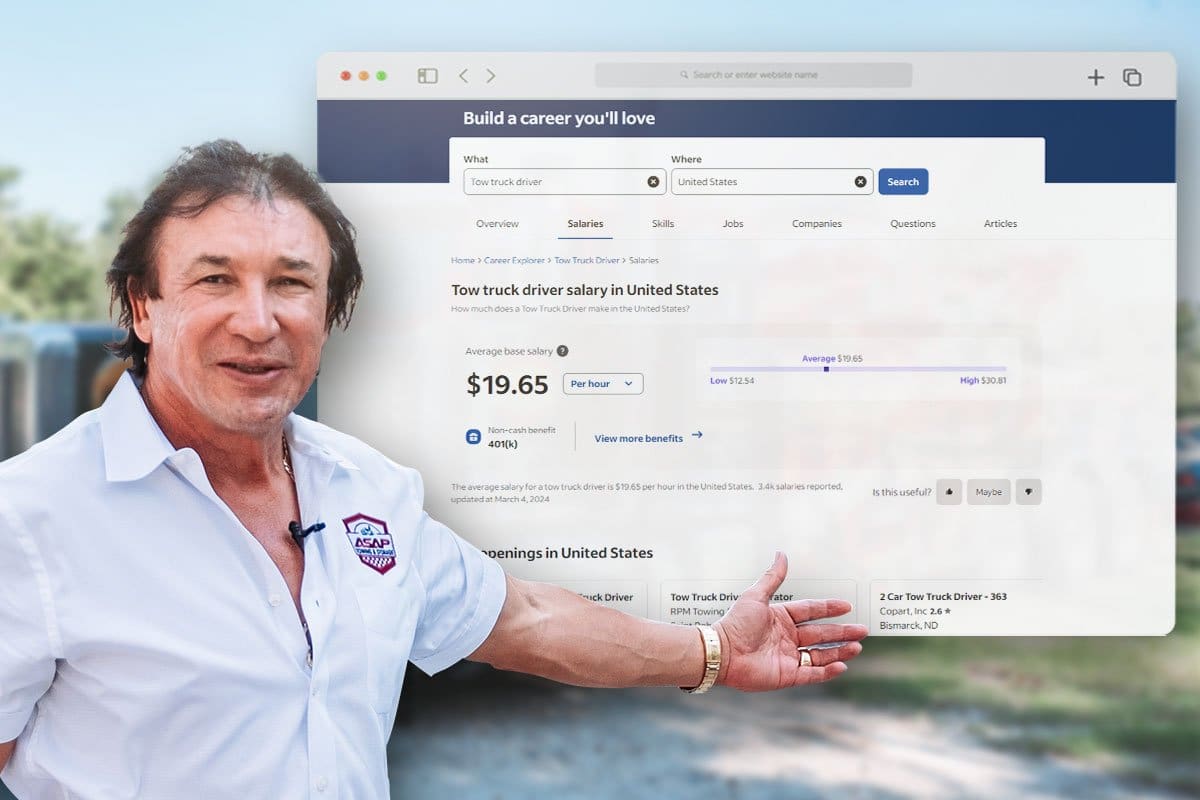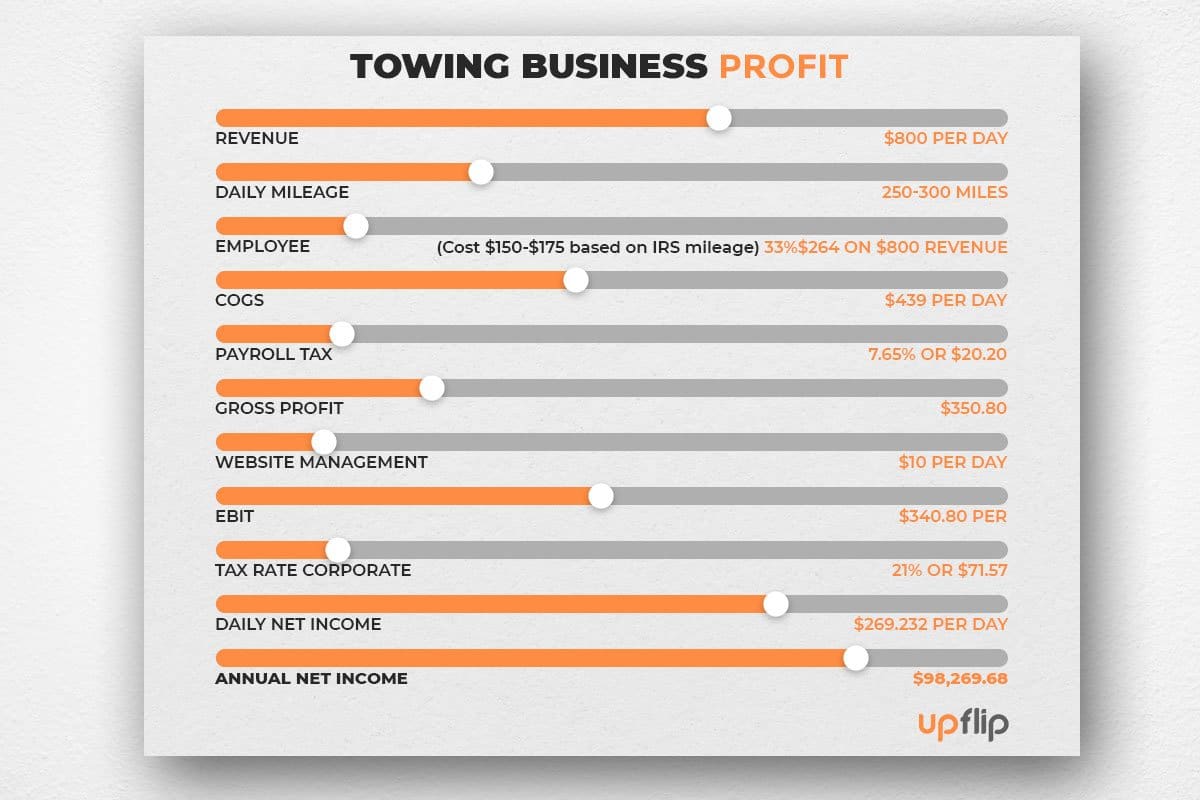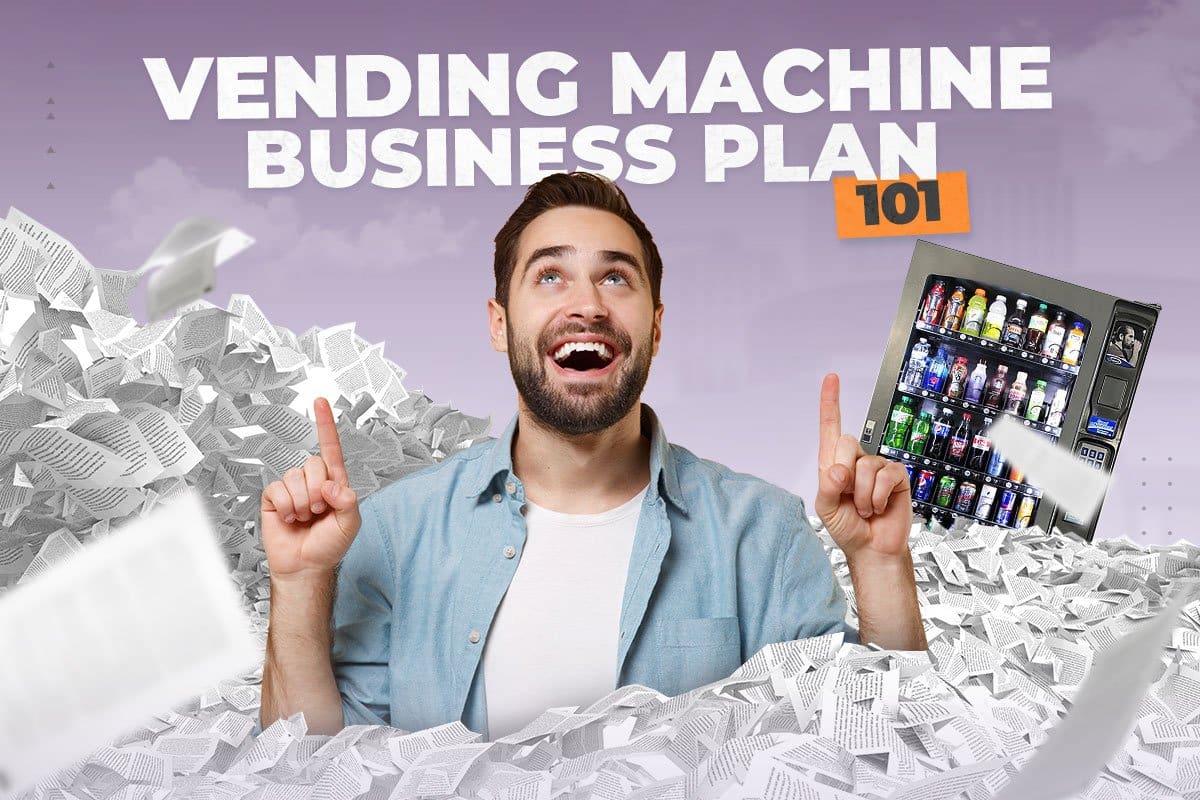Did you know that 69 million vehicles need to be towed each year?
That’s nearly 190K people who call up a towing business every day.
We talked to Vanice and Vincent Serrano, founders of ASAP Towing, to find out how to start a tow truck business that makes more than $10M each year. They provide insights on how towing services make money, how to hire employees, how to become a tow truck driver, and more.
- Tow Truck Business Case Study: ASAP Towing
- Learn About the Towing Industry
- How to Start a Tow Truck Business
- Step #1. Identify Your Target Market
- Step #2. Research Local Regulations
- Step #3. Create a Tow Truck Business Plan
- Step #4. Consider a Startup Loan
- Step #5. Register Your Business
- Step #6. Open a Business Bank Account
- Step #7. Get Tow Truck Business Insurance
- Step #8. Get the Required Licenses and Permits
- Step #9. Buy Equipment and Tools
- Step #10. Develop and Implement a Marketing Strategy
- Step #11. Provide Great Customer Service
- Frequently Asked Questions
- Hiring Tips
- Top Towing Influencers
- Conclusion
Tow Truck Business Case Study: ASAP Towing
Vincent grew up working in auto repair shops owned by his dad, but he wanted to have a business to call his own. They already owned a tow truck and had land, so they decided to start a new tow truck company.
The business venture was mostly Vanice and one employee during its first year. About 18 months in, Vincent had to quit his day job and work at ASAP full time because it was making $250K per year.
The local tow truck company offers towing services for breakdowns, lockouts, accidents, impounds, and more. Check out our interview with Vincent and Vanice below.
Learn About the Towing Industry
Before we discuss how to start a towing company, it’s important to learn all about towing and how the industry operates. We’ll discuss:
- The cost to start a tow truck business
- The amount towing vehicles makes
- Industry profit margins
- Major players
- Industry outlook
- Legal requirements
- How to get a tow truck driver license
How much does it cost to start a tow truck business?
Vincent told us starting your own towing company requires around $10,000 to get a truck, licenses, and towing equipment. We’ll discuss individual costs more in other sections.
How much do tow truck drivers make?

As of January 26, 2024, the average salary for a U.S.-based tow truck driver is $44,198, with a range of $38,820–$50,211, and an average hourly rate of $18.54.
You’ll normally want to pay yourself this salary in addition to some profits from the business when you are an owner-operator.
Your location, experience, employer, skills, and education may impact the pay for tow truck driver jobs. Some drivers will also get bonuses and tips.
According to Indeed, the tow truck driver salary is highest in the following cities:
- Milwaukee, WI
- Sacramento, CA
- Los Angeles, CA
- Austin, TX
- Las Vegas, NV
How much profit can a towing business make?

Transportation businesses normally make 30.59% gross margins and 5.91% net margins. Some people who own towing companies make up to 33.65% profit, which means that the Serranos are likely bringing in somewhere between $700K and $4 million in profits.
Who are the major players in the towing business?
Because many tow truck businesses are privately held companies, it is difficult to find accurate revenue numbers for the largest towing businesses. Along with ASAP Towing, some other large tow truck businesses include:
- United Road Towing: Dun & Bradstreet (D&B) estimates United Road Towing’s annual revenue to be $99M.
- Jamie Davis Towing: ZoomInfo estimates annual revenue is under $5M for this towing company.
- Certified Towing: Revenue is estimated at $1M, according to D&B.
What is the towing industry’s outlook?
IBIS World values the U.S. towing industry at $12.5B and expects it to grow around 2.9% in 2024. They expect it to continue growing at a faster rate after inflation settles down.
Any industry that exceeds the GDP growth in the U.S. is a great one to enter as a business owner.
What are the requirements for a tow company?

Before starting a tow truck company, you will need various tools, permits, and licenses. Consult your local small business office, the DMV, or a lawyer who specializes in tow truck businesses.
A tow trucking company will normally need:
- Drivers with class B driver’s licenses
- Business structure as a limited liability company (LLC) or corporation
- Comprehensive auto insurance with uninsured motorist insurance and higher limits than the state minimum (no less than $250K, but $1M is better)
- Business insurance
- High physical damage insurance
- An oversized vehicle permit (depending on what you will be towing)
- Indictment management permit (if towing without consent)
How to Get a Tow Truck License
To drive a truck with below a 26,000-pound towing capacity, you only need a regular driver’s license. You’ll need a commercial driver’s license (CDL) for anything bigger.
That means you’ll need to take a CDL course, which takes about a month. Then you’ll need to pass the DMV test.
Next, we’ll look at how to start a tow truck business.
How to Start a Tow Truck Business
Starting a tow truck business requires special considerations because of the nature of dealing with vehicular accidents and repossessions. You’ll want to follow the process below to start a successful towing business:
1. Identify your target market.
2. Research local regulations.
3. Create a business plan.
4. Consider a startup loan.
5. Register your business.
6. Get the required licenses and permits.
7. Buy equipment and tools.
8. Develop a marketing strategy.
9. Get liability insurance.
10. Open a business bank account.
11. Provide excellent customer service.
Keep reading to learn how to start a towing business.
Step #1. Identify Your Target Market

Tow truck companies use multiple business strategies to bring in revenue. An indispensable strategy is identifying your target market. Potential customers include:
- Insurance companies: Companies like AAA and Roadside America need towing and roadside assistance for their customers.
- Government agencies: These entities impound cars and need someone to tow them. Not that there may be minimum truck requirements.
- Banks and lenders: Repossession services work with banks and lenders. Learn more about repo laws on the American Recovery Agency website.
- Motorists: Towing businesses can also work with civilians to tow vehicles when they break down or are otherwise immovable.
- Subcontracting: Many businesses outsource their towing needs.
- Automotive companies: A towing business might also work with car dealerships and auto auctions to deliver cars to dealerships or customers.
Step #2. Research Local Regulations
Every towing business needs to understand the local, state, and federal laws that the automobile towing industry operates under. Make sure to check the regulations for all levels of government based on the towing services you provide.
A tow truck operator will normally be governed by federal law in two scenarios:
- Maximum towing capacity for different types of trucks
- Interstate commerce laws, which come into play when commercial vehicles cross state lines
States and local governments will often have laws and regulations that govern the tow truck industry, including minimum tow truck insurance and CDL requirements.
Step #3. Create a Tow Truck Business Plan
You don’t have to write a towing business plan, but it won’t hurt. It will help you keep track of how your towing company is progressing toward its goals. Tow truck business plans should follow a process similar to this:
- Find customers.
- Get your permits and licenses to drive a tow truck.
- Start your company.
- Buy a tow truck.
- Start towing vehicles.
- Follow a marketing plan to take on more work.
- Buy more trucks.
Download our business plan template, then check out our interview with Mike Andes on how to write a business plan below:
Step #4. Consider a Startup Loan
Starting a towing business isn’t cheap. With the cost of a flatbed truck, tow truck insurance, commercial auto insurance, and small business insurance, you can expect to spend $10K to start a towing company. Other sites estimate the tow truck business startup cost can range from $62 to $2M.
- Personal funds or assets
- A loan from family or friends
- Funds from a business partner
- Government programs
- Crowdfunding
- Credit cards
- Home equity loans
- Business loans (Check out our partners.)
- Rollover for business startups (ROBS)
The Small Business Administration (SBA) offers free courses on financing options and funding programs. For info on using personal funds to start a business, check out this article from The Hartford.
Step #5. Register Your Business
Registering a tow truck business will require you to:
- Choose a business name: You’ll want a tow truck business name that is available as a website domain name, social media handle, and registered business name with your secretary of state and the U.S. Patent and Trademark Office. Check domain availability on DreamHost.
- Create a business structure: You’ll want to get either an LLC or a corporation when starting a tow company. You do not want to get a sole proprietorship because it will expose your personal assets to a lawsuit if you get in a wreck with the tow truck.
- Apply for an EIN: An employer identification number (EIN) is required to file taxes for business entities on the IRS website. It is also used to associate employee payroll taxes with the correct company.
- Acquire a sales tax permit: Most states have a sales tax, and you need to adhere to their requirements. This blog isn’t the place to discuss the permits for all 50 states, but Avalara has a guide on sales tax permits. Check it out.
- Labor law posters: All employers must display workplace posters that signal they’re following labor laws. You can download them from the Department of Justice website. You must also follow all hiring laws.
- Unemployment Insurance (UI): You’ll have to pay about $420 per employee on a federal level plus any state UI. Check the U.S. Chamber of Commerce for more information.
Step #6. Open a Business Bank Account
Having an open bank account for your business is crucial to keeping your personal finances and tow truck business finances separate. If you have a limited liability company or a corporation, you’ll also need it to get business loans and personal liability protection.
If you have a business bank account, you can also get a business credit card and potentially commercial truck financing.
Step #7. Get Tow Truck Business Insurance

You’ll want a variety of insurance policies when you own tow trucks. You’ll want:
- Auto liability insurance: covers the vehicle owner if one of their tow truck drivers gets in a wreck
- Uninsured motorist insurance: covers your flatbed truck and your employee if an uninsured driver hits the vehicle
- Workers compensation insurance: covers the medical fees and lost work if employees get hurt or killed on the job
When you own tow truck company assets, you’ll also want various types of business insurance, like general liability, a business owner’s policy, and commercial property insurance. Try Simply Business to get quotes from many of the best business insurance companies.
Step #8. Get the Required Licenses and Permits
As stated, tow trucks may require you to apply for additional permits and licenses. We suggest anyone who wants to tow vehicles reach out to a local business law attorney to verify that they have complied with all laws and regulations.
Step #9. Buy Equipment and Tools
One of the major business expenses for a successful towing company is the cost of flatbed trucks for hauling wrecked vehicles. Some of the places you can find the different types of tow trucks include:
- A bank repoed tow truck sale
- Craigslist
- Auto auctions
- Failing tow truck businesses
- Commercial Truck Trader
Step #10. Develop and Implement a Marketing Strategy
You’ll want to focus on marketing when starting a tow truck business. Vincent suggests using the following marketing for tow trucks:
- Website
- Google Ads
- Instagram and Facebook
- Videos platforms
Launch a Website

Creating a website helps people get the information they need about the services you offer, how much they cost, and where your business is located.
Some services you might list on your website include:
- Roadside assistance
- Repossession services
- Impounding and storage
- Vehicle auctions
- Heavy-duty towing services
Tow places should optimize their website for search engines for search engines. For example, adding a Google Map location to their website’s footer can help it show up higher on Google.
Vincent told us he has one company that does his videos, another that does search engine optimization, and a third that does social media. You can find all-encompassing services, as well.
Google Ads
Your business budget should include some expenses for advertising on Google. Vincent told us:
Instagram and Facebook
Vincent told us that he is fairly new to Instagram, but it is starting to provide some returns. He said he has found success on Facebook.
Videos
Like many business owners, Vincent is starting to get into video marketing.
When you start a tow truck business, you can create videos about the common types of calls a tow operator gets. You can also explain how to do things like change a battery, replace a tire, and what to do in an accident—but make sure not to give any legal advice.
How much should a towing business spend on marketing?

Established tow truck companies should spend between 2% and 10% of desired revenue on marketing, depending on whether they are marketing their towing business to businesses or consumers. Business-to-consumer companies normally spend more on marketing.
According to entrepreneur Thomas Minieri, new companies should spend up to 20% of their target revenue on marketing to help them grow faster. You will normally want to spend between 15% and 20% of your budget on advertising costs.
Despite the suggestions, many small business owners spend much less on marketing. For instance, both Kenneth and Vanice spend less than 1% of their revenue on marketing.
Step #11. Provide Great Customer Service
Tow companies need to provide great customer service. Whether you’re towing for law enforcement, a business, or people in need of repairs, you should try to be compassionate.
Towing companies often provide emergency roadside assistance, but some partner with other businesses to transport vehicles that are (often unintentionally) parked illegally. When someone gets their car towed, remember they may not have known that their car was parked improperly.
Now that you know how to start a tow truck business, let’s look at some frequently asked questions about the industry.
Frequently Asked Questions
We’ll start with the question on everyone’s mind:
How much do tow trucks cost?
There are a few different types of trucks:
- Flatbed tow truck for sale
- Ramp trucks for sale
- Wrecker truck for sale
- Integrated tow truck for sale
In most cases, expect to spend $25K or more.
How can I start a successful tow truck business with no money?

You have to start somewhere. Kenneth suggested the following solutions:
- Can you finance?
- Can you get a lease on a truck?
- Can you ask friends and family?
He also told us:
I wound up going into it on a lease, rent to own. The truck sold for $50,000. By the time I’m done paying for the truck, it’ll be $106,000.
He went on to say:
There are more ways to fund a towing company.
Common funding paths include:
- Personal funds or personal assets
- A loan from family or friends
- Funds from a business partner
- Government programs
The SBA offers free courses on financing options and funding programs. For info on using personal funds to start a business, check out this article from The Hartford.
Running the tow truck company is what you will spend most of your time doing. This includes aspects like hiring employees, helping customers, keeping inventory in stock, accounting, and payroll.
Hiring Tips
Kenneth had a lot to say about hiring drivers. He said the most important aspects of drivers are:
- Do they have the required licensing?
- Do they stay in communication with the owner?
- Do they have mechanical experience, or are they willing to learn?
Without the required licensing, they won’t be able to earn money. But the other aspects are more important to focus on for the bigger picture. Here’s what he had to say about communication:
He also emphasized the importance of being mechanically inclined:
It’s just not gonna happen. You have to take care of the truck. So, if you don’t know how to be a car mechanic, that probably is a tough spot to begin with. I’m even willing to teach you what you need to know. I don’t have a problem with that because we succeed together as a team or we fail as a team.
Top Towing Influencers
Find out what other people in the industry are doing:
- Jamie Davis Towing: Check out his YouTube Channel
- Get Hooked: A towing industry Podcast
Conclusion
We’ve covered how to start a tow truck company; now it’s your turn to get the licenses and permits, find some customers, get a truck, and start towing.
If you’ve already started one, what has been the most challenging part of starting an independent towing service?






